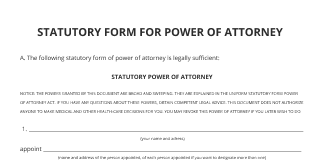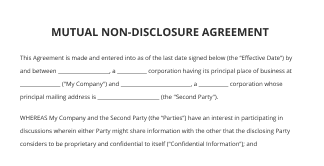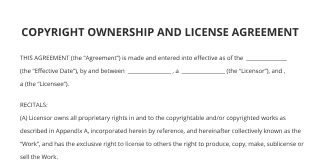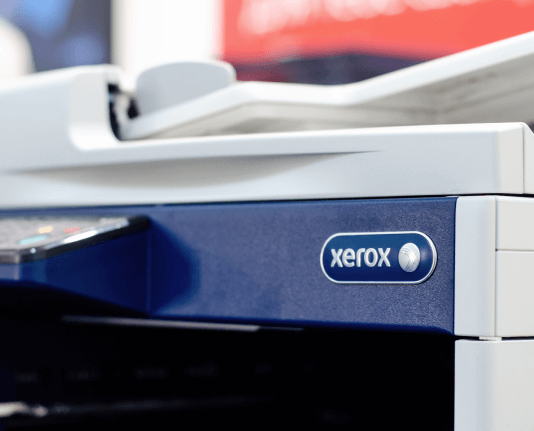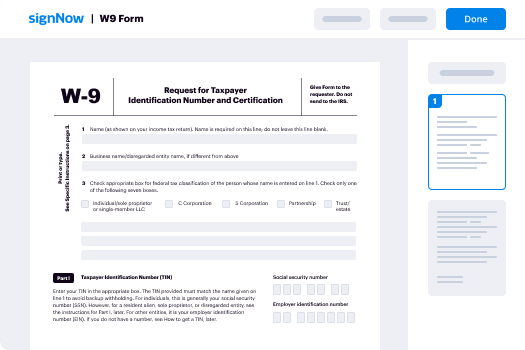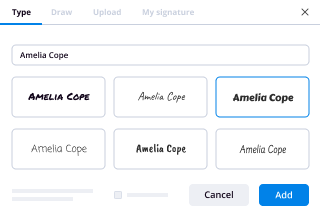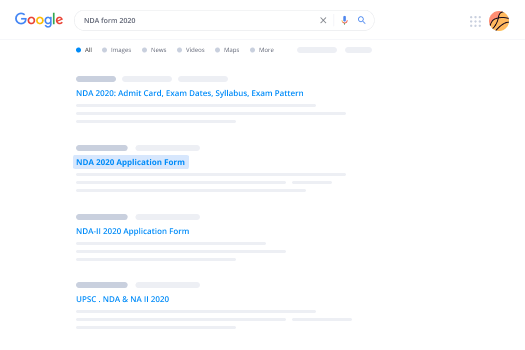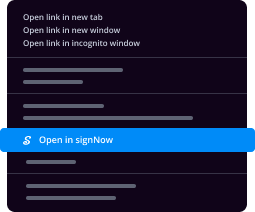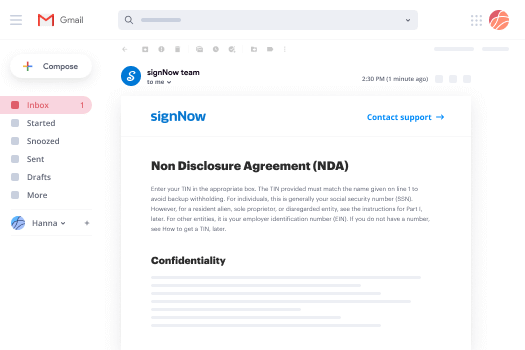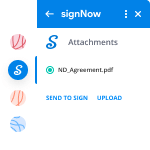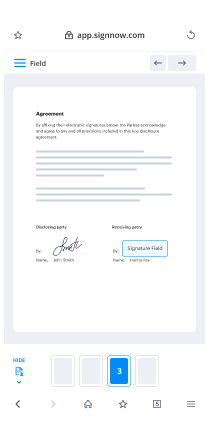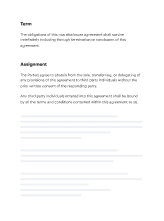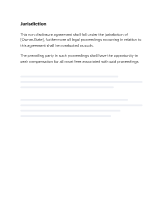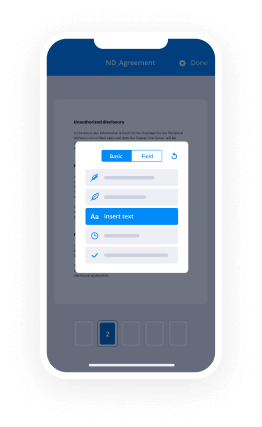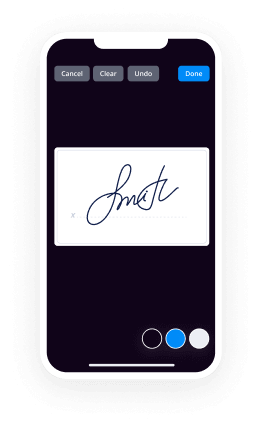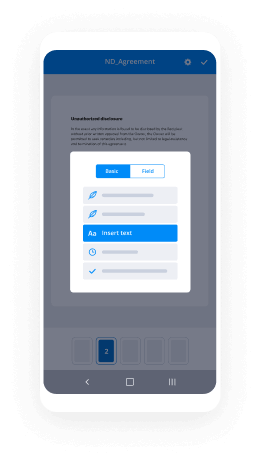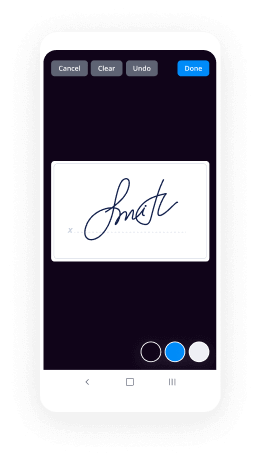Firma Acuerdo De Cobertura Fácil
Mejora tu flujo de trabajo de documentos con airSlate SignNow
Flujos de firma electrónica versátiles
Visibilidad rápida del estado del documento
Configuración de integración fácil y rápida
Firma acuerdo de cobertura en cualquier dispositivo
Registro de auditoría avanzado
Requisitos de seguridad rigurosos
Vea las firmas electrónicas de airSlate SignNow en acción
Soluciones de airSlate SignNow para una mayor eficiencia
Las reseñas de nuestros usuarios hablan por sí mismas






Por qué elegir airSlate SignNow
-
Prueba gratuita de 7 días. Elige el plan que necesitas y pruébalo sin riesgos.
-
Precios honestos para planes completos. airSlate SignNow ofrece planes de suscripción sin cargos adicionales ni tarifas ocultas al renovar.
-
Seguridad de nivel empresarial. airSlate SignNow te ayuda a cumplir con los estándares de seguridad globales.

Tu guía paso a paso — sign hedging agreement
Usando la firma electrónica de airSlate SignNow, cualquier organización puede mejorar los flujos de firma y firmar en línea en tiempo real, brindando una mejor experiencia a clientes y empleados. Usa firma del Acuerdo de Cobertura en unos pocos pasos sencillos. Nuestras aplicaciones móviles portátiles hacen posible trabajar en movimiento, incluso sin conexión! firma electrónica desde cualquier lugar del mundo y realiza tareas en poco tiempo.
Cómo completar y firmar un sign hedging agreement
- Inicia sesión en tu perfil de airSlate SignNow.
- Encuentra tu documento en tus carpetas o sube uno nuevo.
- Accede a la plantilla ajustando usando el menú Herramientas.
- Arrastra y suelta campos rellenables, añade texto y firma electrónicamente.
- Añade varios firmantes mediante correos electrónicos y configura el orden de firma.
- Indica qué usuarios pueden recibir un documento firmado.
- Utiliza Opciones avanzadas para reducir el acceso al registro y establecer una fecha de vencimiento.
- Presiona Guardar y Cerrar cuando termines.
Además, hay funciones más extendidas disponibles para firma del Acuerdo de Cobertura. Incluye usuarios en tu espacio de trabajo colaborativo, navega por los equipos y monitorea la colaboración. Millones de usuarios en EE. UU. y Europa concuerdan en que un sistema que une a las personas en un área de trabajo cohesiva, es lo que las empresas necesitan para mantener los flujos de trabajo funcionando sin problemas. La API REST de airSlate SignNow te permite integrar firmas electrónicas en tu aplicación, sitio web, CRM o nube. Prueba airSlate SignNow y obtén flujos de firma electrónica más rápidos, suaves y en general más productivos!
Cómo funciona
Funciones de airSlate SignNow que los usuarios adoran
Vea resultados excepcionales sign hedging agreement
¡Obtenga firmas legalmente vinculantes ahora!
Preguntas frecuentes sign hedging agreement
-
¿Cómo funciona la cobertura?
La cobertura se refiere a comprar una inversión diseñada para reducir el riesgo de pérdidas de otra inversión. Los inversores a menudo compran una inversión opuesta para hacer esto, como usar una opción de venta para cubrirse contra pérdidas en una posición en acciones, ya que una pérdida en la acción será en cierta medida compensada por una ganancia en la opción. -
¿Qué es la cobertura en términos simples?
Significado de cobertura. La cobertura, en finanzas, es una estrategia de gestión de riesgos. Se trata de reducir o eliminar el riesgo de incertidumbre. ... En términos simples, es cubrir una inversión invirtiendo en otra inversión. Generalmente, cuando las personas planean cubrirse, intentan asegurarse contra un evento negativo. -
¿Qué quieres decir con cobertura?
Una estrategia de gestión de riesgos utilizada para limitar o compensar la probabilidad de pérdida por fluctuaciones en los precios de productos básicos, monedas o valores. En efecto, la cobertura es una transferencia de riesgo sin comprar pólizas de seguro. -
¿Qué quieres decir con cobertura en finanzas?
Cubrirse contra el riesgo de inversión significa usar estratégicamente instrumentos financieros o estrategias de mercado para compensar el riesgo de movimientos adversos en los precios. ... Entonces, la cobertura, en su mayor parte, no es una técnica para ganar dinero, sino para reducir pérdidas potenciales. -
¿Qué es un acuerdo de cobertura?
Un acuerdo de cobertura significa cualquier swap, tope, collar, compra a plazo o acuerdos o arreglos similares relacionados con tasas de interés, tipos de cambio o precios de commodities, ya sea en general o bajo contingencias específicas. Basado en 148 documentos 148. \uff0b Nueva lista. -
¿Cuáles son las actividades de cobertura?
La cobertura es una estrategia de gestión de riesgos empleada para compensar pérdidas en inversiones. La reducción del riesgo generalmente resulta en una reducción de las ganancias potenciales. Las estrategias de cobertura generalmente involucran derivados, como opciones y futuros. -
¿Qué significa cubrir un préstamo?
Cubrirse contra el riesgo de inversión significa usar estratégicamente instrumentos financieros o estrategias de mercado para compensar el riesgo de movimientos adversos en los precios. ... Entonces, la cobertura, en su mayor parte, no es una técnica para ganar dinero, sino para reducir pérdidas potenciales. -
¿Cómo se usa hedge en una oración?
Termina la poda de todos los árboles de hoja caduca y setos lo antes posible. ... Los setos son de FIG. inglesa ... A menudo se cortan para formar setos en jardines. ... Los setos más pequeños pueden estar formados por boj perenne o por arbustos de árbol. ... Al cortar, el seto (como en realidad todos los setos) debe ser XVI. -
¿Cómo ganan dinero los fondos de cobertura?
El fondo de cobertura gana dinero cobrando una tarifa de gestión y una tarifa de rendimiento. Aunque estas tarifas difieren según el fondo, generalmente son del 2% y del 20% de los activos bajo gestión. Tarifas de gestión: Esta tarifa se calcula como un porcentaje de los activos bajo gestión. ... Este incentivo motiva al fondo a generar rendimientos excesivos. -
¿Por qué el acuerdo maestro de ISDA?
El Acuerdo Maestro de ISDA es el contrato estándar utilizado para gobernar todas las transacciones de derivados OTC (sobre mercado) celebradas entre las partes. ... El propósito del Acuerdo Maestro de ISDA es establecer disposiciones que rijan la relación general de las partes1. -
¿Cómo se cubre el USD?
Pida prestado la moneda extranjera en una cantidad equivalente al valor presente del recepcionista. ... Convierta la moneda extranjera en moneda nacional a la tasa de cambio spot. Deposite la moneda nacional a la tasa de interés vigente.
Lo que dicen los usuarios activos — sign hedging agreement
Búsquedas relacionadas con sign hedging agreement
Sign hedging agreement
[Music] okay let's talk about foreign currency transactions and hedging foreign exchange risk so if we're gonna pay somebody in a foreign currency in the future we're gonna receive a foreign currency in the future we've got a risk that that foreign currency is gonna fluctuate in value between now and the time that we have to make our payment or receive our payment and the basic rule is going to be that the underlying transaction has to be marked to market every time we prepare financial statements so there may be a gain or a loss on that basic transaction and if we decide to hedge it with a forward contract which we'll talk about in a second or an option which we'll talk about in a second that thing also has to get marked to market each time we do an income statement and a balance sheet so let's look at our base case we are an American company so we sell something to a German company and they agree to pass 90 days from now and they agree to pay us a million euros at the spot rate in other words as of December 1st of the as of the day we book the sale it takes a dollar 30 to to buy one euro so we'll take those million euros they gave them to us today and turn them into one main three hundred twenty thousand dollars well book an account receivable and to remind ourselves that we're going to get paid in Euros we'll put a Euro sign out there this number is a million three hundred twenty thousand dollars every dollar on our income statement and our balance sheet is in American dollars but we'll put this little euro sign to remind us that we're going to get paid in Euros that we'll have to later convert to dollars December 31st rolls around and we have to prepare an income statement and a balance sheet the spot rate has gone up the foreign exchange rate has made the Euro stronger which is good news for us my friend jet says ARF's and that reminds me that if I have an account receivable expressed in a foreign currency on my books I want that foreign currency to get stronger so that when I do get that foreign currency it buys more US dollars so remember our rule the underlying transaction and the hitch we'll get the hedges in a second have to be on our books at fair value so we write that account receivable up with a debit of $10,000 and we book a foreign exchange gain of ten thousand dollars because the spot rate has gone up from one point three two to one point three three as of December 31st so even though we haven't realized the gain yet we book an unrealized gain of ten thousand dollars then March 1st comes and we have to write our account receivable to market the spot rate is down the Euro has become less valuable it's gotten weaker so we booked a foreign exchange loss and reduced account receivable and what I'm going to do in this video is any income statement account it's going to be in red font other than sales so we can see what's happening with all the foreign exchange gains and losses and things then they pay us let's use this account here called it's a cash account called foreign currency euros it tells us that we would receive some euros we got a check if you will for a million euros that equates to remain three hundred thousand dollars that takes the account receivable off our books and we turn that euros those main euros into 1.3 million u.s. dollars so net net we've had a twenty thousand dollar loss a ten thousand dollar gain in the year one and a thirty thousand dollar loss in year two well we may find that unacceptable we may not want to have that kind of risk so we're gonna hedge our selves we're gonna make other bets to protect ourselves one mechanism would be to sign a forward contract so we go to a bank and say we're going to have a million euros 90 days from now what kind of rate will you give us 90 days from now and that's called the forward rate if the interest rates the foreign currency are lower the forward rate is going to be higher than the spot rate in this case the euro rate is a little bit higher so it trades at a discount to the spot rate and the forward rate is 1.30 five so we're willing to lock in the fact that we'll get fifteen thousand dollars less just so we don't have to worry about things so the first journal entry is the same we know we're going to receive a million euros the spot rate as of December 1st is still a buck 32 so our best guess as to what we're going to receive is a million euros that will convert into a main three hundred and twenty thousand dollars there's nothing to book for the Ford contract it's an executor II contract and all we're doing is saying we'll exchange 1 million euros with you for one man three hundred and five thousand US dollars 90 days from now we get to December 31st and it's time to mark the underlying transaction in the market spot rate has gone up when I have an account receivable doesn't it in a foreign currency I wanted to get stronger and that's what's happened here so I've got that ten thousand dollar FX game but now that contract has a liability attached to it it's not such a good deal well how do we find the fair value of a forward contract we look at what kind of deal we would get at December 31st if we sign that forward contract then well-formed contracts are traded all the time we can see on December 31st if we had bought a forward contract and into a forward contract for euros on March 1st what would the exchange rate be and we discovered be one point three one six so that means if we had waited we would have gotten an $11,000 more than we did by locking in on December 1st but that's not gonna happen for two months so we've got to find the present value of that 11 thousand dollars to find out how bad a deal we got here so we can go to our financial calculator we can clear the third row we can say that 2 is the end if we're in a 12% per year borrowing market that means that our incremental cost per month is 1% and we've got $11,000 is the future value let's change the sign on that just so we'll get a positive number that spits out and we'll compute PV and we get 10,000 $783 so that's the liability that's created by this forward contract as of December 31st okay let's go to March first the spot rate has gone the wrong direction as far as our underlying transaction goes so we got to write that account receivable down by $30,000 and book a for exchange loss that contract is now worth 5,000 because the spot rate may be a buck thirty but we've locked in one point three zero five so we're going to get an extra $5,000 above the spot rate because we locked in so we've got to take that asset we've got to create an asset where there was a liability that liability had bounced of ten thousand seven hundred eighty three to make it $5,000 asset we're going to have to debit Ford contract for fifteen thousand seven eighty three we're gonna have a gain on the Ford contract again the income statement accounts are in red we received the check the check is in Euros but it's worth 1.3 million we take that check and we take it off our books when we turn it into US dollars that contract rate is one point three zero five to make that journal entry balance we take the Ford contract off our books with a five thousand dollar credit and so now we've turned that man euros into one lane three hundred and five thousand US dollars I'm sorry I've looked at all these numbers in red you would discover that we end up losing like fifteen thousand dollars and that makes sense we locked in a man 305 and the original transaction wouldn't it this the main three hundred and twenty thousand but the timings off a little bit you look at this year we've got a ten thousand dollar gain and a ten thousand seven hundred eighty three loss so what we can do the Mercedes Benz of hedges if you will is the cash flow hedge that allows us to match dollar-for-dollar the gains and losses on the underlying transaction so I like to think of the cash flow heads as using the accumulated other comprehensive income garage everything related to that hedge will first be stored in here and then brought out as we need it to match the dollars and so what's going to happen is we're gonna have to do things artificially that happened naturally when we used it as a fair value hedge so we booked the same transaction just like we always have we're gonna get a million euros at the December first though the spot rate is 1.3 - so we debit that accounts receivable and credit sick at first the euro gets stronger so as of December 31st we've got a $10,000 game we decided previously that that Ford contract was a liability of 10000 783 but instead of debiting loss account here on Ford contract we stored in our garage 10 783 gets stored in the garage how many dollars do we need to bring out of the garage to match this $10,000 game $10,000 so we take $10,000 out of accumulated other comprehensive income and book it as the loss on the Ford country and then since we're doing everything artificially we're going to have to amortize that $15,000 discount remember instead of getting main 320,000 we've agreed that we'll get a May and 305 so we find the effective rate of the transaction clear the third row the transaction is three months we were going to get a man three hundred and twenty thousand dollars at the spot rate that's the present value and said we're gonna get a man 305 by virtue of our forward contract so we change the sign and make that the forward value and then we compute the I and we get 0.38 since this is a calculator that's in a percent already so it's point zero zero three eight and if you're using the 12th edition of Hoyles advance to County and there's a mistake in there that typo is it shouldn't be one minus the cube root of the present value in with a future value over the present value it should be the cube root of the future value over the present value minus one and that's how you get this - point zero zero three eight so we take that point zero zero three eight multiplied times to $15,000 and we write off five thousand and nineteen and even the advanced accounting book says that's a lot of work let's just use straight line from now on so it's fifteen thousand dollars over three months five thousand bucks a month March first comes along the Euro has gotten weaker so we've got that $30,000 loss that we've talked about before that Ford contract is now an asset so we have to increase it with a fifteen thousand seven hundred eighty three dollar debit we don't book a game instead we put everything in the garage so we credit accumulated other comprehensive income how much do we need to pull out of the garage thirty thousand dollars so we take thirty thousand dollars out of the a OCI garage and book thirty thousand loss for the game we amortize the last that fifteen thousand dollar discount and in the future this will just be ten thousand five thousand one month and then ten thousand for the next two months we receive the euros which at the spot rate are worth a man thirty million three hundred thousand dollars then we take those euros and take them off our books and we get a man 305 by virtue of the forward contract and we take the forward contract off our books with a five thousand dollar credit so a fair value hedge is just a fine hedge but it's gonna have timing problems if we want to use the Mercedes Benz of hedges we'll use the cash flow hedge and everybody date will mark the underlined transaction to mark it will use a o CI to mark our hedge to market we'll take whatever we need out of the garage they a OCI garage to offset whatever happened on the underlying transaction and then on the forward contract we should amortize using the effective interest rate now let's talk about using an option and what we're gonna do there is everything's pretty similar except that when we're using a cash flow hedge we'll book the change in time value because eventually the time value of that option will be zero so let's my an option and treat it as a fair value edge so we book the sale just like we always have and now we buy a foreign currency option that gives us the right but not the obligation on march first to sell a million euros for main three hundred and twenty thousand dollars in other words the spot rate how do we know how much that option cost well the other party tells us if you want to buy this option across nine thousand dollars we can buy it on an exchange or maybe we have a single counterparty that we work with then December 31st comes and just like before the euro has moved in the right direction we wanted to get stronger it has so we've got a ten thousand dollar game this is a fair value hedge so let's mark that option - it's fair value let's take a look and its intrinsic value and it's time value to get a feel for its total value every option has two parts the intrinsic value is it a good deal or a bad deal right now well our option was to sell these things that a buck 32 there's no Vantage to that that's the market rate so all that $9,000 value has to be the time value the notion that there's 90 days and it could turn into a good deal or it sometime over the next 90 days so it's December 31st and we find out that the total value of the option is $6,000 well since the intrinsic value is 0 it makes even less sense now to to exercise that option some for a buck there - when they can sell for a book 33 so the intrinsic value must be 0 since the fair value is $6,000 our counterparty tells us that that means the time value must be $6,000 so we've got to write off the $3,000 as we go from 9 thousand to six thousand so that's what we're doing when we do a loss on foreign currency option we reduce that on our books from 9000 down to $6,000 night so now we get to March first well the spot rate has gone down so on the underlying transaction we've got a $30,000 loss that option is now worth $20,000 the spot rate is $1 in 30 cents but we have an option to sell for a buck 32 so that's an extra $20,000 that option was on our books for an $6,000 so we've got to ride it up by 14 and we've got a gain on foreign currency option and so now we received the million three hundred thousand dollars worth of euros take that off our books but we have the option to sell them from Maine three hundred and twenty thousand so when we turn those euros that were on our books into US dollar we get a man $320,000 how do we make that drill into Donald's credit that option for $20,000 remember it was originally on our books for nine we wrote it down to six then we wrote it back up by 14 so that it would have a debit balance of 20 and now we'll take it off our bounds with a credit of $20,000 so lastly let's look at that option but this time called a cash flow option the Mercedes Benz of hedges so that we can match up the time and differences dollar-for-dollar same entry here book the sale have done that many times now put that foreign currency option on our books for $9,000 because that's what we paid for it December 31st comes along the euros gotten stronger so we have a $10,000 gain on the underlying transaction that foreign currency option is down by 3,000 dollars of value when everyone from 9,000 to 6,000 but instead of booking a loss we parked that $3,000 in the garage we need $10,000 to come out of the garage to offset that $10,000 gain so we reduce accumulated other comprehensive income and we book a loss on foreign currency option and then we have to take 3,000 bucks out to recognize the expense that we're going to amortize that $9,000 we have to do artificially what happened automatically in the fair value option so here's our $3,000 getting rid of or reducing the time value of that option so we get to March first we've got that $30,000 loss because the spot rate has gone down so on the underlying transaction we've got a $30,000 loss the option is now worth $20,000 so it was on our books for six before so we write it up by 14 we store that in other comprehensive income we take out the $30,000 gain out of the garage to offset the $30,000 loss we book $6,000 of amortization expense to get rid of the time value of that option so that we're just left with the intrinsic value of the option which is 20,000 bucks and again we're doing artificially what happened naturally want to treat it as a fair value hedge we collect the main euros that are worth the main three on our books take the receivable off our books we exercise our option and so we have a man $320,000 for the u.s. dollars we take that receivable off our books and we take that foreign exchange option off our books so if we're looking at coils 12th edition of advanced accounting this is the order they treat things we have a count we have an actual asset and the calves receivable or an account payable on our books we can hedge it with a Ford contract that locks in our game and our loss we can treat it as a cash flow hedge that's the mercedes-benz because we can solve all the timing differences or we contribute as a fair value hedge which is the accounting the debits and credits are exactly the same as any other trading security except we get to have a special footnote there the only problem with the fair value and edges that the timings gonna be off we also could use an option by an insurance policy like we just did for $9,000 we can treat that as a cash flow hedge or treat that as a fair value hedge we could have a firm commitment so we know we're gonna prepare something for a client but we can't send the invoice because we haven't earned it yet well we can still protect ourselves we can have a forward contract and treat that as a cash flow hedge or a fair value hedge the 12th edition of advanced accounting about hole does not walk us through the cash flow hedge version of that but it exists we can do this so we can have an option even though it's just a firm commitment and again it the book doesn't walk us through a cash flow hedge but it could and instead it just walks us through a fair value hedge and finally we could have a forecast to transact it's probable that we're going to be doing business we're in the habit of doing a man euros worth of business every third quarter of every year so we can anticipate that with a Ford contract and we have to treat that as a cash flow hedge there's no such thing as a fair value hedge for a forecast of transaction or we could use an option and treat it as a cash flow hedge and don't forget that if we screw up and we don't meet the three tests if we don't have something ahead if we don't have heads and efficiently and if we don't properly designate it it's not the end of the world we're still going to get the debits and credits of a fair value hedge but without the benefit of a footnote that talks about our hedging abilities and our hedging capabilities and we won't get to use the cash flow hedge which we like a lot because it solves all the timing differences all right so I hope this makes chapter nine of the book easier to read [Music] you [Music]
Show more




